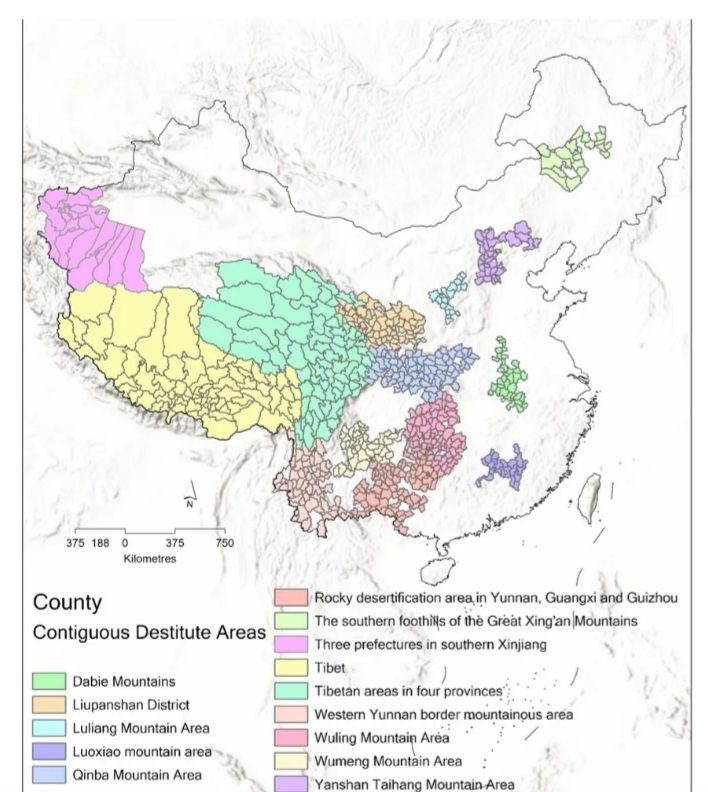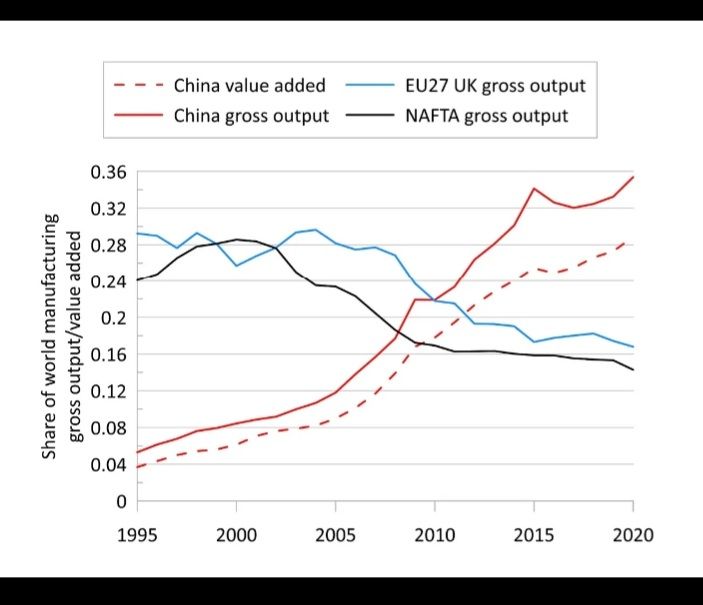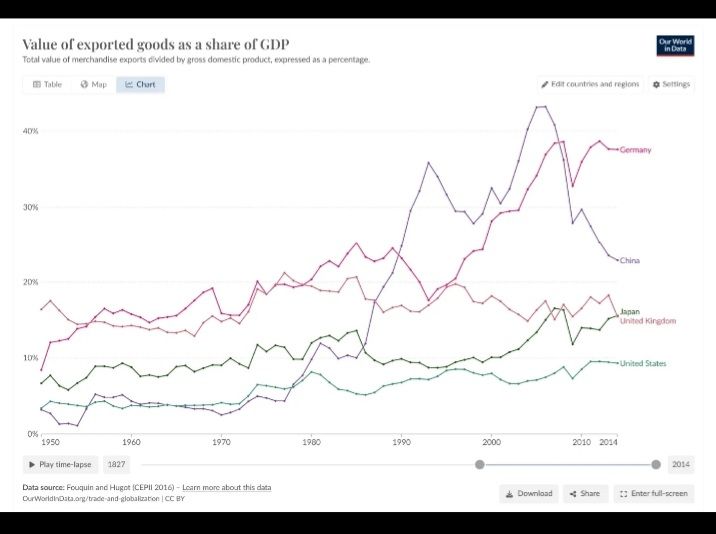10/04/24
Political economists Radhika Desai (Professor, University of Manitoba; Director, Geopolitical Economy Research Group) and Michael Hudson (Distinguished Research Professor of Economics at University of Missouri) are joined by Beijing-based scholar Mick Dunford – who is the Professor Emeritus of Geography at Sussex University, and now working at the Chinese Academy of Sciences – to discuss China’s economy and debunk Western media myths, addressing accusations that consumption is too low, fears of “Japanification”, the role of exports, and the new Chinese growth strategy.
We shall summarise the discussion (scheer post and YouTube) by utilising their presented illustrated graphics.
- That China remains an upper middle income country where the average levels of consumption are less than those in economically much, much richer countries.

And that the decline in the share of household consumption expenditure has occurred as GDP has increased at astonishing rates. Therefore, the actual real value of consumption in China has increased enormously over the course of time, and it continues to increase at this present point in time. It is a country which has 400 million people who are in the middle income categories with an enormous market potentialities.
A supplementary graph shall be this:

2. Poverty Alleviation in the Contiguous Destitute Area

In these places, there were 80 million people whose income was less than US$1.96 per day, but, between 2013 and 2020, every single one of these people were lifted above the poverty line and often lifted well above it through an extraordinary program of poverty alleviation.
3. Gross Fixed Capital Formation

And, that China has grown essentially by increasing the share of investment in its GDP.
If you invest, you employ people; the people who are employed receive wages whereby they are used to purchase goods and services. So, investment actually also gets translated into an increased consumption pattern.
4. Industrial Manufacturing “Value-Added”

The Australian Strategic Policy Institute has documented that China’s global lead extends to 37 out of 44 technologies covering technological fields like defense, space, robotics, energy, environment, biotechnology, artificial intelligence, advanced materials, and quantum technology.
China is undergoing this current process of structural change designed to significantly upgrade existing industries, basically to use new technologies in order to upgrade and improve the quality of these industries.
The next chart plots world GDP growth from the middle of the 1960s and world export growth. What it shows very, very clearly is that the growth rate of China’s world exports (real growth) considerably exceeded the rate of growth of world GDP.

5. Export Growth
China’s exports grew at something like 18.1% per year up until the financial crisis over a period of nearly 30 years which are absolutely astonishing. Then with the 2008 financial crisis, exports dropped to 9.4%. Since 2013, China’s exports have grown at 5.7%.

In the case of China, this change in the global situation obviously is one of the reasons for China’s somewhat slower growth, but China’s rate of growth is still consistent with its long term objectives in relation to increasing GDP, and GDP per head, by 2035.

6. China’s position in World GDP and Export Growth

China’s growth, the market stimulus for China’s growth is increasingly coming from China’s own economy. Similarly, this parameter goes for the import of intermediate inputs. China is importing fewer intermediate inputs which means that firms within China are increasingly producing the inputs that were previously being imported into China. So, in that sense, growth in China and also in the rest of the developing world, though to a lesser extent, is becoming less reliant on trade growth.
7. Gross Exports as share of GDP.
This red line shows China, gross exports as a share of gross output or GDP from 1995 to 2017. One can see that this is the developing countries excluding China:

China is importing fewer intermediate inputs, which means that firms within China are increasingly producing the inputs that were previously being imported into China. The growth in China, and also in the rest of the developing world, is becoming less reliant on trade growth.
8. Export-linked manufacturing as a percentage of manufacturing

Export-linked manufacturing peaked for China in about 2006; since then it has declined. The domestic sales of China’s manufactured goods is growing faster than export sales.
9. China’s Domestic Market
China’s domestic market is going to be a significant focus of future growth.
Germany’s BMW has moved its production to China. China is not importing chemicals from Germany because BASF has moved its chemical operations to China. There is a movement of Germany into China, and much of the increase and the decrease in world trade relative to GDP, which means domestic self-reliance, is a result of China’s role itself.
For the Belt and Road Initiative and implementation processes, it is to make them independent of the US and NATO countries because the US and NATO countries do not want more trade with China. The World Trade Organization is really coming to an end.
10. Global South Economies
China is the main trade partner of 140 countries in the world that are largely part of the Global South. In the recent neoliberal era-pandemic period-globalisation fractionalised situation, the Global South economies have actually grown relatively slower. That’s one of the reasons for this relatively slow growth of China’s world trade recently that has come to depend more on these emerging and low-income countries.
A supplementary graph on China Exports to selective major Global South trading partners:

However, South-South trade is going to grow very substantially. China has a very strong commitment to the maintenance of an open world economy, and in the establishment of complementary relationships.
In the longer term, the export market will continue to play a really very significant role in China’s growth. This will be much more connected with the development of other parts of the Global South.
A supplementary graph on China Exports to Global South vs US + Europe:

11. Uptake of productivity by increasing investment
The really important things about what is happening in China now is that it is talking about a new path of modernization that is different from the path that was followed by the Western world, and it involves many dimensions.
Obviously, it involves emphasis upon productivity increasing technologies; what drives growth is actually the rapid diffusion of technology. The rapid diffusion of technology depends on investment. So investment in a sense leads to rapid uptake of productivity thereby increasing investment in a circular pattern.
12. Socialism with Chinese characteristics
Chinese thought is obviously a synthesis of Marxism, but also with earlier Chinese traditions.
If one looks at Chinese ideas about international relations, the core concept is harmony. Actually, it is the idea of harmony and living in harmonious relationships with others, which means understanding the kind of internal dynamic of others and then working with them to develop their potentialities, rather than imposing upon nation-states.
The core concepts in Chinese international relations are things like guānxi (关系), or “relationality”; or gòngshēng (共生), which means symbiosis; or tiānxià (天下), or “all under heaven”.
China looks at the whole economy by looking at growth of the whole society as an organism. One is talking about transformation whereby transformation and redistribution is much more important than growth, (World Bank, 2022); the World Bank and DRC have identified the whole-of-government and whole-of-society approach.
EPILOGUE
Based on domestic great circulation, we will coordinate and promote the construction of a strong domestic market and the construction of a trade powerhouse (贸易强国), form a powerful gravitational field to attract global resources and factors of production, promote the coordinated development of domestic and foreign demand, imports and exports, and the introduction of foreign capital and foreign investment, and accelerate the cultivation of new advantages to be used in international cooperation and competition. China’s 14th Five Year Plan: Article XIII – Promoting domestic-international dual circulation.
Article 13 of this policy refers to promoting a domestic-international dual circulation. Based on domestic great circulation, the country will coordinate and promote the construction of a strong domestic market and the construction of a trade powerhouse. Therefore, both domestic market and foreign market are important to form a powerful gravitational field to attract global resources and factors of production, promote the coordinated development of domestic and foreign demand, imports and exports, and the introduction of foreign capital and foreign investment, and accelerate the cultivation of new advantages to be used in international cooperation and competition.
RELATED
Capital imperfection and Socialism effectiveness economic model
China’s socio-economic rise and America’s capitalism collapse

Pingback: FRIDAY FILES 12th April 2024 – MOMENTUM